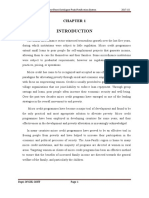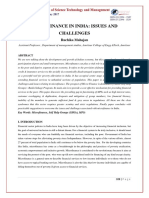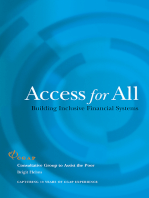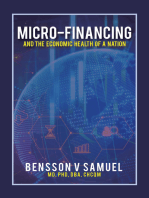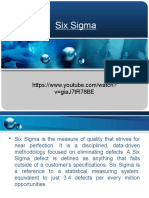0 ratings0% found this document useful (0 votes)
31 viewsGrameen Bank: Taking Capitalism To The Poor 2004
Grameen Bank: Taking Capitalism To The Poor 2004
Uploaded by
Hemant ChaudharyGrameen Bank originated in Bangladesh in the 1970s to provide small loans to the poor, especially women. It has since expanded significantly. The bank targets the poorest populations, especially women, and uses a group lending model to manage risk. It has also established related organizations to further its social and financial goals. Evaluations show generally positive short-term effects on poverty reduction, though questions remain about long-term sustainability and profitability. The bank's greatest impact may be societal through empowering women rather than financial returns.
Copyright:
© All Rights Reserved
Available Formats
Download as PPTX, PDF, TXT or read online from Scribd
Grameen Bank: Taking Capitalism To The Poor 2004
Grameen Bank: Taking Capitalism To The Poor 2004
Uploaded by
Hemant Chaudhary0 ratings0% found this document useful (0 votes)
31 views22 pagesGrameen Bank originated in Bangladesh in the 1970s to provide small loans to the poor, especially women. It has since expanded significantly. The bank targets the poorest populations, especially women, and uses a group lending model to manage risk. It has also established related organizations to further its social and financial goals. Evaluations show generally positive short-term effects on poverty reduction, though questions remain about long-term sustainability and profitability. The bank's greatest impact may be societal through empowering women rather than financial returns.
Original Title
Grameen Bank
Copyright
© © All Rights Reserved
Available Formats
PPTX, PDF, TXT or read online from Scribd
Share this document
Did you find this document useful?
Is this content inappropriate?
Grameen Bank originated in Bangladesh in the 1970s to provide small loans to the poor, especially women. It has since expanded significantly. The bank targets the poorest populations, especially women, and uses a group lending model to manage risk. It has also established related organizations to further its social and financial goals. Evaluations show generally positive short-term effects on poverty reduction, though questions remain about long-term sustainability and profitability. The bank's greatest impact may be societal through empowering women rather than financial returns.
Copyright:
© All Rights Reserved
Available Formats
Download as PPTX, PDF, TXT or read online from Scribd
Download as pptx, pdf, or txt
0 ratings0% found this document useful (0 votes)
31 views22 pagesGrameen Bank: Taking Capitalism To The Poor 2004
Grameen Bank: Taking Capitalism To The Poor 2004
Uploaded by
Hemant ChaudharyGrameen Bank originated in Bangladesh in the 1970s to provide small loans to the poor, especially women. It has since expanded significantly. The bank targets the poorest populations, especially women, and uses a group lending model to manage risk. It has also established related organizations to further its social and financial goals. Evaluations show generally positive short-term effects on poverty reduction, though questions remain about long-term sustainability and profitability. The bank's greatest impact may be societal through empowering women rather than financial returns.
Copyright:
© All Rights Reserved
Available Formats
Download as PPTX, PDF, TXT or read online from Scribd
Download as pptx, pdf, or txt
You are on page 1of 22
Grameen Bank: Taking
Capitalism to the Poor 2004
Executive Summary
Grameen Bank’s origins, structure, culture,
performance and efforts to expand and
broaden the microfinance agenda.
The authors evaluate Grameen’s success in
implementing Yunus’s vision in the light of
various challenges and conclude that the
short-run effects of microcredit have been
positive and that microfinance will continue
to make important contributions to poverty
reduction.
The social benefits in terms of the
empowerment of women and its positive
impact on human capital—must question
whether such an institution will ever generate
sufficient returns to profit-driven
shareholders to attract the sort of capital
required to enable it to reach all segments of
the poor.
The legacy of Grameen Bank will ultimately
be not what it has done for shareholders, but
how it has impacted society.
Introduction: The Origins of Grameen
Bank
The story behind the first concerted effort to make
financing accessible to the world’s poorest is the stuff
of folklore.
Befitting the goal of poverty alleviation, the setting for
this early experiment was a time of great tragedy in
Bangladesh, one of the poorest countries in the world.
A small country in the Indian subcontinent with a
population of 130 million, a gross national product
(GNP) per capita of about $300 and a literacy rate of
only 38 percent for those over 15 years of age,1
Bangladesh experienced drought and famine in 1974
that killed 1.5 million people (Macfarlane 2002).
Credit Delivery System
Targets the Poorest of the Poorand Is Owned
by the Poor
Group Lending
Risk Management
Compensation/Recognition
Growth
Culture: The 16 Decisions
Borrowers need to abide by a set of paternalistic
rules central to Grameen Bank’s culture and its
success—and that members reportedly recite with
pride.
These guidelines range from an adherence to
Grameen principles—discipline, unity, courage, hard
work through the building of family prosperity—to
encouragement to repair and improve houses, grow
vegetables year-round, plant seedlings each year,
build and repair pit-latrines, introduce physical
exercise in centers and neither request nor offer
dowries.
The guidelines also insist on self-reliance,
liberating borrowers from the victim
mentality and stressing that the whole
community (of 8–10 groups) must not allow
anyone to fall behind.
These are effective in a society in which the
infant-mortality rate is high, disease spreads
quickly due to poor sanitation and ravages
communities, natural disasters are common
and educational attainment is low.
Coping with Crises
1) 1995 Boycott Movement
In 1995, Grameen Bank experienced its first major
operational crisis. Men in the communities joined
local politicians who disapproved of the bank’s
mission of turning women into entrepreneurs and
pressured borrowers to stop repaying loans.
This boycott movement explicitly challenged
Grameen Bank to eliminate a charge imposed on
borrowers who chose to leave a borrowing group.
2) 1998 Floods
The bank was still emerging from the challenge of
the boycott movement when in 1998 floods
ravaged the country, leaving much of the
population without homes and business.
The bank went into the bond markets and received
a Tk 1 billion loan from the Central Bank of
Bangladesh and a Tk 2 billion loan from
commercial banks in Bangladesh to cover massive
defaults and to disburse new loans to borrowers
who had been made destitute.
3) Issues of Transparency and Credibility
These incidents provided Grameen’s
management with important information about
weaknesses due to rigidity in the loan process.
This approach left individuals with loans in arrears
with few options, as they lacked access to credit
and savings to meet fixed interest and principal
payments and reenterthe loan process.
Grameen Bank II
Grameen Bank underwent a major
restructuring by which it refocused on a
central tenet of the bank’s original philosophy.
The poor always pay back. From this
restructuring process emerged Grameen Bank
II, which was conceived in 1999 and
implemented from 2000 to 2003.
The main changes to the classic Grameen
system included simplifying loan
classifications and offering greater flexibility
for loan repayments.
Grameen Bank II include the Grameen Pension
fund and Grameen Loan Insurance.
Grameen had offered more than a dozen kinds of
loans, including seasonal, family and general loans.
In order to avoid the confusion and needless
redundancy resulting from this breadth of
offerings, Grameen II starts all first-time borrowers
with a Basic Loan in one of only three loan
categories that correspond to three different annual
interest rates: development or entrepreneurship (20
percent), housing (8 percent) or education (5
percent).
The Grameen Bank II loan program is described as a
highway, on which women that remain within the
system and meet all terms of their loans graduate
to progressively larger loans.
Diversifying Grameen
Grameen Bank has also helped establish a number
of related organizations to support its mission,
although it has chosen to support them with debt
financing rather than assumed equity stakes.
These organizations are separate legal entities that
began as projects and were later spun off. Grameen
Bank made loans into a trust fund (the Grameen
Fund) from which disbursements were made to the
companies.
The companies were then expected to pay back
the loans at a later stage.
One of the organizations that expanded and
diversified the bank’s activities was the Grameen
Krishi Foundation (GKF), which focuses on
agriculture and provides loans to groups of farmers
owning between 0.5 and 3 acres of land. Since
Grameen Bank itself does not loan money for
agricultural production, through GKF it is able to
do so.
Grameen Bank also has helped found 17 Grameen
Network companies, which provide basic services
that many Grameen Bank borrowers require. They
are independent companies that have not received
any loans from Grameen Bank and pay regular
taxes and duties.
Summary of Grameen Bank’s Strategy, Risk Management, Growth and
Compensation
Strategy
Target a unique client base—largely rural women.
Integrate social and financial goals and create lasting partnerships with the
microfinance community to grow the global base of microfinance.
Lobby governmental organizations to increase visibility of microfinance initiatives.
Growth
No donor funds since 1995.
90% of loans funded through income and deposits.
Started Grameen-branded businesses but limited its risk to small loan.
commitments; organizations are left to run as independent entities.
Risk Management
First line of risk management is the loan group of women from the same village.
Women put pressure on one another because default affects the ability of each
member in the group to take loans.
This is the most important factor in keeping defaults low.
Next line of defense is surprise internal audits.
Quarterly monitoring and evaluation.
Surprise center visits by branch managers.
Compensation
Managed and operated by savers and borrowers
Exporting the Model and Building
Lasting Financial Institutions
Grameen Bank Replication Program -The success of
Grameen Bank has spawned a rash of not-for-profit and for-profit
organizations attempting to mimic the model.
In 1999, the Grameen Foundation, and offshoot of Grameen Bank
established as a not-for-profit entity to spread the Grameen Bank
mission, established the Grameen Bank Replication Program (GBRP)
to provide financial and technical resources to help launch new
microfinance programs.
The Consultative Group to Assist the Poorest (CGAP), a consortium
of 28 development organizations dedicated to expanding access to
financial services for the poor, has been instrumental in
establishing guidelines, best practices, regulation and
measurement techniques for assessing the effectiveness of
organizations in the field of microfinance.
For-Profit Microcredit Models-
The not-for-profit model, several for-profit
corporations have embraced microfinance either as
a stand-alone business model or as an operating
unit of the corporation.
The largest of these corporations, in terms of total
assets, is Bank Rakyat of Indonesia (BRI).
BRI has more than $3 billion in total assets devoted
to microfinance,21 which accounts for one-third of
its total lending. 22 BRI went public at the end of
2003 in the largest IPO in Indonesia since the Asian
financial crisis.
Microcredit Summit Campaign and
Sustainability of Microcredit-
Grameen Bank’s influence extends well beyond its own
organization. For example, the bank was instrumental in
setting up the Microcredit Summit Campaign (MSC) in
1997.
At the inaugural meeting, 2,900 people from 1,500
microcredit organizations and137 countries united to
launch a campaign to provide financing to 100 million
of the world’s poorest by 2005.
Beyond defining its target clientele, the MSC established
four main goals:
•Reaching the poorest.
•Reaching and empowering women.
•Building financially self-sufficient institutions.
•Ensuring a positive, measurable impact on the lives of
clients and their families.
Evaluating Grameen Bank
Grameen Bank’s success must be measured in
terms of both social and financial standards.
Furthermore, one must first ask whether the bank
is a successful social program before turning to its
performance as a financial institution. Grameen
Bank is a successful social program that combats
poverty by addressing the specific needs of the
neediest in society, with a particular emphasis on
women.
Women’s increased empowerment may explain the
fundamentalist Islamic Party’s loss of 14 of its 17
parliamentary seats in the June 1996 Bangladeshi
elections after it expressed opposition to
microcredit and women’s rights. In those elections,
for the first time in Bangladeshi history more
women than men voted.
Conclusions
Grameen Bank has become one of the largest enterprises in
Bangladesh and has lifted millions of people—mostly women
and their families—out of poverty. Given Khandker’s findings
(1998) that “as much as 5 per cent of program-participating
households should be able to lift their families out of poverty
every year,” the 4.2 million women already reached through
BRAC and Grameen Bank in Bangladesh translate into 21
million family members.
Grameen Bank and microcredit as a whole, despite the
respectable performance of both. Grameen Bank has adjusted
in response to many of the criticisms surrounding reporting,
openness and sustainability and has reduced its reliance on
public funds and private donors. Still, returns on equity and
assets remain too low to attract serious investment, and the
authors believe this reality is unlikely to change unless
Grameen adopts a different, less socially oriented model.
THANKING YOU-
PRESENTED BY-
ALINA JAVED 15/IMB/009
ANJALI RATHI 15/IMB/013
ANANT MITTAL 15/IMB/011
AMAN SINGH 15/IMB/010
ADITYA BHATI 15/IMB/008
ANKUR 15/IMB/014
You might also like
- SWOT Analysis of Grameen BankDocument9 pagesSWOT Analysis of Grameen Bankনিশীথিনী কুহুরানীNo ratings yet
- Grameen Bank (Bangladesh)Document19 pagesGrameen Bank (Bangladesh)Haqiqat AliNo ratings yet
- The Functional Microfinance Bank: Strategies for SurvivalFrom EverandThe Functional Microfinance Bank: Strategies for SurvivalNo ratings yet
- Grameen BankDocument13 pagesGrameen BankrabiaarshadNo ratings yet
- Grameen Bank - Bank For The PoorDocument2 pagesGrameen Bank - Bank For The Pooruyenminh2211No ratings yet
- Grameen BankDocument6 pagesGrameen Bankaknipon2004No ratings yet
- Week34 Grameen ApproachDocument26 pagesWeek34 Grameen ApproachGilarie AlisonNo ratings yet
- History of MicrofinanceDocument21 pagesHistory of MicrofinancevitalkumarNo ratings yet
- Case Study On Grameen BankDocument7 pagesCase Study On Grameen BankShruti Patel75% (4)
- 53 Microfinance Revolution and The Grameen Bank Experience in Bangladesh20190805-48922-1a68le6-With-Cover-Page-V2Document62 pages53 Microfinance Revolution and The Grameen Bank Experience in Bangladesh20190805-48922-1a68le6-With-Cover-Page-V2Hidayatullah GanieNo ratings yet
- Grameen BankDocument4 pagesGrameen BankonyrulanamNo ratings yet
- The Importance of Microcredit Programs in Sustainable DevelopmentDocument4 pagesThe Importance of Microcredit Programs in Sustainable DevelopmentSafdar IqbalNo ratings yet
- Concept of Micro CreditDocument16 pagesConcept of Micro CreditSyed Wahidur RahmanNo ratings yet
- Are Grameen Replication SustainableDocument14 pagesAre Grameen Replication SustainableadminNo ratings yet
- Grameen Bank: Introduction To Micro CreditDocument6 pagesGrameen Bank: Introduction To Micro CreditAzharul Islam RobinNo ratings yet
- Sustainable Development GoalsDocument14 pagesSustainable Development Goalskrrish khemaniNo ratings yet
- The Success of Rural Microfinance at Grameen Bank in BangladeshDocument10 pagesThe Success of Rural Microfinance at Grameen Bank in BangladeshNafiz FahimNo ratings yet
- Bankers To The Poor: Click To Edit Master Subtitle StyleDocument34 pagesBankers To The Poor: Click To Edit Master Subtitle StylerajkumarbeheraNo ratings yet
- The Grameen BankDocument7 pagesThe Grameen BankBalkis BanuNo ratings yet
- Concept Paper On The Bank of The Poor - Grameen Bank Microfinance SystemDocument4 pagesConcept Paper On The Bank of The Poor - Grameen Bank Microfinance SystemGanesh ShakyaNo ratings yet
- Micro FinanceDocument5 pagesMicro FinancePayal SharmaNo ratings yet
- Session 1 - Grameen BankDocument5 pagesSession 1 - Grameen BankagyeyaNo ratings yet
- Grameen BankDocument8 pagesGrameen BankAbdul Basith ShaikhNo ratings yet
- 2014-VII-1&2 NilimaDocument13 pages2014-VII-1&2 NilimaAPOORVA GUPTANo ratings yet
- Grameen Bank: Bengali Microfinance Community Development Bank Bangladesh Loans Microcredit CollateralDocument8 pagesGrameen Bank: Bengali Microfinance Community Development Bank Bangladesh Loans Microcredit CollateralJyoti ShelarNo ratings yet
- MicrofinanceDocument8 pagesMicrofinanceshahrafatzamanNo ratings yet
- Grameen - CaseDocument17 pagesGrameen - CaseFadel Khalif MuhammadNo ratings yet
- First and ForemostDocument7 pagesFirst and ForemostZakeyo Dala ChabingaNo ratings yet
- MicrofinanceDocument69 pagesMicrofinanceSimranNo ratings yet
- The Experience of Grameen BankDocument5 pagesThe Experience of Grameen BankNagendra SinghNo ratings yet
- Grameen BankDocument5 pagesGrameen BankNitin ChidrawarNo ratings yet
- The Impact of Microcredit and Poverty Reduction: Bushra Chowdhury MouDocument18 pagesThe Impact of Microcredit and Poverty Reduction: Bushra Chowdhury MouRagel ahmedNo ratings yet
- SMART PUSHNOTE - An Agent Based Intelligent Push Notification System 2017-18Document60 pagesSMART PUSHNOTE - An Agent Based Intelligent Push Notification System 2017-18sachin mohanNo ratings yet
- Microfinance Case StudyDocument5 pagesMicrofinance Case StudyArun SinghNo ratings yet
- 1.1 MicrocreditDocument18 pages1.1 MicrocreditMahbub SkyNo ratings yet
- Self Help GroupsDocument12 pagesSelf Help GroupsunknownNo ratings yet
- Notes - Unit 2Document10 pagesNotes - Unit 2ishita sabooNo ratings yet
- The Definition of MicrofinanceDocument6 pagesThe Definition of MicrofinanceAyush BhavsarNo ratings yet
- Gram EenDocument6 pagesGram EenShadreck K WisdomzNo ratings yet
- AJAD 2006 3 1 2 2thapaDocument22 pagesAJAD 2006 3 1 2 2thapaNishit RelanNo ratings yet
- Microfinance and Its Impact On IndiaDocument60 pagesMicrofinance and Its Impact On Indiabagal07100% (1)
- A Study On Microfinance Sector in KarnatakaDocument84 pagesA Study On Microfinance Sector in KarnatakaPrashanth PB100% (5)
- NGO (Grameen Bank)Document14 pagesNGO (Grameen Bank)aulad999No ratings yet
- CH Allen EgsDocument5 pagesCH Allen EgsY N S Y SNo ratings yet
- A Grameen Bank Concept: Micro-Credit and Poverty Alleviation Program in BangladeshDocument5 pagesA Grameen Bank Concept: Micro-Credit and Poverty Alleviation Program in BangladeshMuhammad Al HafizhNo ratings yet
- Overview of Micro FinanceDocument9 pagesOverview of Micro FinanceRafiuddin BiplabNo ratings yet
- Journal - Impact of Microcredit Inrural Areas of Morocco. Evidence From A Randomized EvaluationDocument31 pagesJournal - Impact of Microcredit Inrural Areas of Morocco. Evidence From A Randomized EvaluationAgustina EkaNo ratings yet
- A Grameen Bank Concept: Micro-Credit and Poverty Alleviation Program in BangladeshDocument6 pagesA Grameen Bank Concept: Micro-Credit and Poverty Alleviation Program in BangladeshNafiz FahimNo ratings yet
- Microfinance Chapter 1Document27 pagesMicrofinance Chapter 1Prakash KumarNo ratings yet
- Lecture 16Document7 pagesLecture 16Zaisha RahmanNo ratings yet
- Apoyo Exp EmprededurismoDocument5 pagesApoyo Exp EmprededurismoArlesPegueroNo ratings yet
- A Study On Role and Effects of Microfinance Banks in Rural Areas in India 1Document63 pagesA Study On Role and Effects of Microfinance Banks in Rural Areas in India 1Rohit KumarNo ratings yet
- A Study On Role and Effects of Microfinance Banks in Rural Areas in India 2Document55 pagesA Study On Role and Effects of Microfinance Banks in Rural Areas in India 2Rohit KumarNo ratings yet
- Self Help Groups in India - A Study On Kavach SHG: by Abhishek KarishiddimathDocument10 pagesSelf Help Groups in India - A Study On Kavach SHG: by Abhishek KarishiddimathRahul SinghNo ratings yet
- A Radical Solution for the Problems of Bankruptcy and Financial Bottlenecks for Individuals and CompaniesFrom EverandA Radical Solution for the Problems of Bankruptcy and Financial Bottlenecks for Individuals and CompaniesNo ratings yet
- Agricultural Finance for Smallholder Farmers: Rethinking Traditional Microfinance Risk and Cost Management ApproachesFrom EverandAgricultural Finance for Smallholder Farmers: Rethinking Traditional Microfinance Risk and Cost Management ApproachesNo ratings yet
- Inclusive Business in Financing: Where Commercial Opportunity and Sustainability ConvergeFrom EverandInclusive Business in Financing: Where Commercial Opportunity and Sustainability ConvergeNo ratings yet
- Micro-Financing and the Economic Health of a NationFrom EverandMicro-Financing and the Economic Health of a NationNo ratings yet
- Hitt Chapter 10 Corporate GovernanceDocument34 pagesHitt Chapter 10 Corporate GovernanceHemant ChaudharyNo ratings yet
- Six Sigma Quiz (30-9-2020) - 1Document4 pagesSix Sigma Quiz (30-9-2020) - 1Hemant ChaudharyNo ratings yet
- Extensions and Tests of The Classical Model of TradeDocument28 pagesExtensions and Tests of The Classical Model of TradeHemant ChaudharyNo ratings yet
- Dea 5Document16 pagesDea 5Hemant ChaudharyNo ratings yet
- Hitt Chapter 11-Organizational Structure and ControlsDocument38 pagesHitt Chapter 11-Organizational Structure and ControlsHemant ChaudharyNo ratings yet
- Acquisition and Restructuring StrategiesDocument32 pagesAcquisition and Restructuring StrategiesHemant ChaudharyNo ratings yet
- Team BuildingDocument33 pagesTeam BuildingHemant Chaudhary100% (1)
- Six SigmaDocument46 pagesSix SigmaHemant ChaudharyNo ratings yet
- Presentation Submitted To: Dr. Kavita Singh Submitted By: Snigdha Abhi Nishant Tushar MansiDocument20 pagesPresentation Submitted To: Dr. Kavita Singh Submitted By: Snigdha Abhi Nishant Tushar MansiHemant ChaudharyNo ratings yet
- Integrated BBA - MBA (IX Semester)Document1 pageIntegrated BBA - MBA (IX Semester)Hemant ChaudharyNo ratings yet
- Name:-Hemant ROLL NO: - 16/IMB/043Document10 pagesName:-Hemant ROLL NO: - 16/IMB/043Hemant ChaudharyNo ratings yet
- ANOVA Gage R & RDocument12 pagesANOVA Gage R & RHemant ChaudharyNo ratings yet
- A Comparative Study On Customer Satisfaction Towards Airtel and JIO With Special Reference To Coimbatore (West)Document4 pagesA Comparative Study On Customer Satisfaction Towards Airtel and JIO With Special Reference To Coimbatore (West)Hemant ChaudharyNo ratings yet
- CR - Note SummaryDocument92 pagesCR - Note SummaryHemant ChaudharyNo ratings yet
- Name:-Shyamveer ROLL NO: - 16/IMB/045Document9 pagesName:-Shyamveer ROLL NO: - 16/IMB/045Hemant ChaudharyNo ratings yet
- ResumeDocument5 pagesResumeHemant ChaudharyNo ratings yet
- Islamic Banking: Assigned By: Kundan Kumar 2K19/BBA/86 Assigned To: Ma'Am Paras ChannarDocument5 pagesIslamic Banking: Assigned By: Kundan Kumar 2K19/BBA/86 Assigned To: Ma'Am Paras ChannarKundan kumarNo ratings yet
- GNCC Fathers' Day Dinner 11june2016Document1 pageGNCC Fathers' Day Dinner 11june2016wms_klangNo ratings yet
- Recent Trends in Management Set 1Document6 pagesRecent Trends in Management Set 1Balaram BeheraNo ratings yet
- Key Fact Statement CorporateDocument7 pagesKey Fact Statement CorporateRAM MAURYANo ratings yet
- Stanley's WorkDocument33 pagesStanley's WorkdavidtitangohNo ratings yet
- Current Affairs Q&A PDF Top 100 - November 2021 by AffairsCloud 1Document39 pagesCurrent Affairs Q&A PDF Top 100 - November 2021 by AffairsCloud 1Sumit JanrodeNo ratings yet
- Module 1Document11 pagesModule 1Angelica Marie DalisayNo ratings yet
- Personal Interview Notice For Diploma Mechanical EngineeringDocument6 pagesPersonal Interview Notice For Diploma Mechanical EngineeringadhikaripankhuriNo ratings yet
- Final Project 16 March-1Document38 pagesFinal Project 16 March-1jupiter stationeryNo ratings yet
- Learning Module in Financial ManagementDocument56 pagesLearning Module in Financial ManagementAlexandra Denise PeraltaNo ratings yet
- Account Statement 030523 021123Document37 pagesAccount Statement 030523 021123manish thakurNo ratings yet
- Tariff of Charges - 08-01-2024Document37 pagesTariff of Charges - 08-01-2024mays.kadinNo ratings yet
- SMS Bankig Application - FormDocument2 pagesSMS Bankig Application - FormCtg TalkNo ratings yet
- Samjhana KALPANADocument63 pagesSamjhana KALPANAbishnu paudelNo ratings yet
- Forex Manual CompleteDocument468 pagesForex Manual CompleteNouman SarwarNo ratings yet
- Consumer Mathematics PART 1 LESSON 5Document24 pagesConsumer Mathematics PART 1 LESSON 5Althea Noelfei QuisaganNo ratings yet
- Bank Statement and InvoicesDocument7 pagesBank Statement and Invoicessyedqamarabbas2000No ratings yet
- Prajakta Sarwate ABSLDocument3 pagesPrajakta Sarwate ABSLneeta ilheNo ratings yet
- ToR - Exposure Visit Siinqee Bank Final 10.11.22Document4 pagesToR - Exposure Visit Siinqee Bank Final 10.11.22Wg Iddeessa100% (1)
- JjmehtaDocument5 pagesJjmehtabarnikNo ratings yet
- HDFC Bank LTDDocument1 pageHDFC Bank LTDmargaj5552No ratings yet
- PR R Krishnamurthy June10 20214Document7 pagesPR R Krishnamurthy June10 20214Karthikeyan RK SwamyNo ratings yet
- Schedule of Bank Charges Bank Al HabibDocument11 pagesSchedule of Bank Charges Bank Al HabibLala JanNo ratings yet
- Neurogen 1st NRRT - 1 Week Combined PackageDocument5 pagesNeurogen 1st NRRT - 1 Week Combined Packagezahir2020No ratings yet
- June 2015 p1 (With Answers)Document14 pagesJune 2015 p1 (With Answers)Ashleigh JacksonNo ratings yet
- 3911 14074 1 PBDocument9 pages3911 14074 1 PBAlfatih LimaugliqNo ratings yet
- Sbi Po Mains Result 2023Document4 pagesSbi Po Mains Result 2023Robin SinghNo ratings yet
- Mithila Sultana Full ReportDocument67 pagesMithila Sultana Full ReportMithila SultanaNo ratings yet
- Conversation For Changing A Medical AppointmentDocument2 pagesConversation For Changing A Medical AppointmentmowenesolNo ratings yet
- 5015 3042 IPRUTOUCH Transactions ManualDocument26 pages5015 3042 IPRUTOUCH Transactions Manualdhiraj kubdeNo ratings yet
































